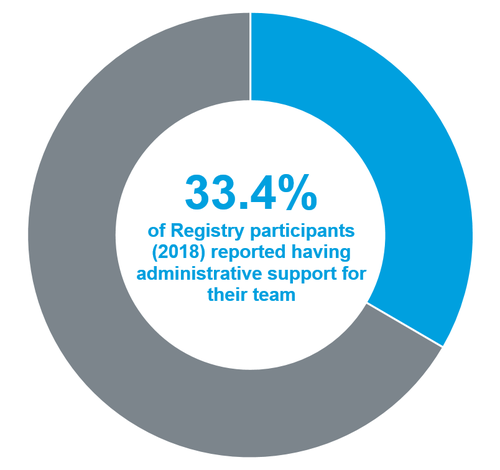Utilizing Administrative Support to their Highest Potential

I’ve often heard palliative care programs lament the struggle of meeting the needs of patient care, leadership, and educational responsibilities with their current staffing levels. If a clinician is spending three hours collecting and analyzing operational data, or organizing the next palliative care 'lunch and learn', that’s three less hours they can spend caring for people living with a serious illness. Assistance in alleviating some of these administrative burdens, however, may be closer at hand than you think.
Assistance in alleviating some of these administrative burdens, however, may be closer at hand than you think.
In the National Palliative Care Registry™ 2018 hospital survey, one-third of participating programs report having administrative support for their program.

Some may think this is not a substantial number, but in the survey, administrative support came in at sixth on the list of most prevalent team members after the core interdisciplinary team (physician, nurse practitioner, social worker, chaplain, and registered nurse). If you question their potential contribution, I would argue that when utilized to their highest potential, administrative support can relieve many of the day-to-day stresses of an active palliative care team.
I would argue that when utilized to their highest potential, administrative support can relieve many of the day-to-day stresses of an active palliative care team.
Before joining the staff of the Center to Advance Palliative Care (CAPC), I was in an administrative support role at a 500-bed hospital in New Jersey. There, I served as a business coordinator for one palliative care team, and eventually supported all of the palliative care programs across the health system.
In this blog post, I'm excited to share my story from my time in an administrative support role, including ways that I supported palliative care teams on a day-to-day basis.
Data, Data, Data…
Something on the top of every palliative care team’s mind is data collection.
While studies have shown that specialty palliative care improves patients’ symptom burden and quality of life, while decreasing hospital costs, programs are consistently asked to prove their worth to their own organizations. In that frame of mind, up-to-date data collection and reporting was always my priority. I created a standard data collection tool for our team’s clinicians – whenever they completed a patient consult (either because they had signed-off or the patient had been discharged from the hospital), they would provide me with the completed tool and a copy of the consult note for data entry. At that time, EHR integration was not as prevalent as it is now, so I stuck with the classic “build a database in Microsoft Excel” model. Even though I was quite familiar with the software, I took a few Excel classes through the health system’s continuing education program to “up my game”, and was soon making tables and filtering data to generate program reports.
[Palliative care] programs are consistently asked to prove their worth to their own organizations. In that frame of mind, up-to-date data collection and reporting was always my priority.
My familiarity with the data allowed me to translate collection into standardized and regular reporting for our key stakeholders. It was my job to create a one-page dashboard to share not only within our team, but also with hospital and system leadership. These dashboards were also reviewed by the hospital foundation’s palliative care steering committee – concrete examples of the palliative care team’s impact helped motivate the committee to identify new philanthropic support opportunities.
Who’s Going to Take the Next Patient?
Before I joined the palliative care team, new patient referrals came in through the printer in our program manager’s office. We didn’t have a centralized office location at that time, so the physicians, nurse practitioners, and chaplain would have to run back to our manager’s office multiple times a day to see if any new consult requests had come in. As I settled into my job, checking the printer became one of my responsibilities. Additionally, while all patient assignments were ultimately left to the clinicians, I learned the specialties and workloads of the team with time and was able to triage accordingly. For example:
- John, an advanced practice registered nurse, has a background in oncology care – if he’s available, maybe he can see this patient with newly diagnosed pancreatic cancer
- The Neuro ICU appreciates Dr. Smith’s insights because of her experience with Rehabilitation Medicine – let’s ask if she can take this new patient
- Dr. Jones already has three family meetings scheduled for today – if one of the other clinicians is available for a new consult, let’s try them first
If no clinicians were available, our chaplain would visit the new patient’s nurses and doctors to learn more about the consult request. Once a team member became available, we were equipped with additional information to provide on that patient’s individual needs.
Much More than Direct Patient Care
Education initiatives were also an important part of the palliative care team’s activities. Our clinicians were committed to sharing their knowledge of palliative care skills that could improve the experience of patients hospital-wide. One of our team’s nurse practitioners was also an End-of-Life Nursing Education Consortium (ELNEC) trainer. In conjunction with other nurse champions from throughout the hospital, she would host an ELNEC Core course once or twice a year. Not only would the team serve as faculty for the course, but they also had to plan it as well. I was happy to join their efforts and take some of the event planning burden from them. As I could devote time to the administrative aspects of the courses (e.g., scheduling rooms, preparing handouts), we were able to not only plan ELNEC trainings at our own hospital, but also in additional locations across the health system.
Around the same time that I joined the palliative care team, the Practitioner Orders for Life-Sustaining Treatment (POLST) form went into use in New Jersey. As our program manager had been on the state’s POLST steering committee, we were uniquely poised to provide POLST education throughout the hospital. Everything from what a POLST form was to how to tag one in the patient’s chart were necessary discussion topics. I attended multiple staff meetings with the hospital’s unit representatives, explaining the new document, and how it should be processed upon admission and discharge. This also allowed me to help with data collection for a physician’s quality improvement project on POLST implementation.
As the demand for palliative care continues to grow, the need for high-functioning teams is critical.
“A Jack or Jane of All Trades”
As the demand for palliative care continues to grow, the need for high-functioning teams is critical. If you currently have administrative support, or hope to hire some in the future, make sure they are being utilized to their highest potential. With the proper training and support, these team members can efficiently do much more than you may expect, contributing in their own right to the provision of high-quality palliative care.
With the proper training and support, these team members can efficiently do much more than you may expect, contributing in their own right to the provision of high-quality palliative care.
